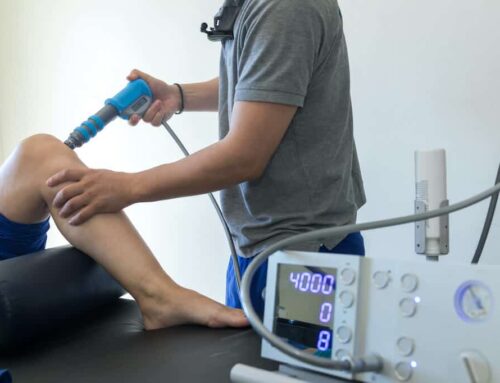Many cyclists experience knee pain while cycling. Oftentimes, it’s after you’ve been pedaling for a while and then that nagging feeling starts. Most commonly, it begins at the side of your knee or right over your knee cap. You start to mess with your cleat position, or change your saddle height, but it’s still there. No matter what you change with your fit, or how much foam rolling you do, the pain keeps coming back. Oftentimes, it’s because that knee pain while cycling that you’re experiencing may be coming from your back.
How The Muscles In Our Back Affect Our Hips And Knees
In our back, there are muscles that help stabilize our spine. The ones closest to our spine (and therefore most important in stabilizing it) are the multifidi. They are responsible for rotational movement. As cyclists, we move in just one plane: forward. Therefore, the muscles that perform rotation of our trunk are used less and less and become weak. When a muscle is weak, other muscles have to try to take over for it in order to stabilize our spine appropriately. When muscles have to do tasks that aren’t their job, they tighten and stay tight. (This is why we also see a lot of cyclists with back pain and tightness).
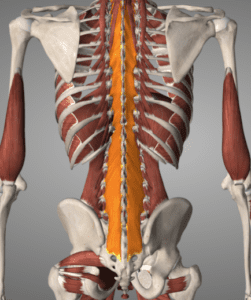
The multifidi muscles, responsible for stabilizing and rotating our spine
Next up, The Hips
You’ll notice that our multifidi connect all the way down to our pelvis and sacrum.
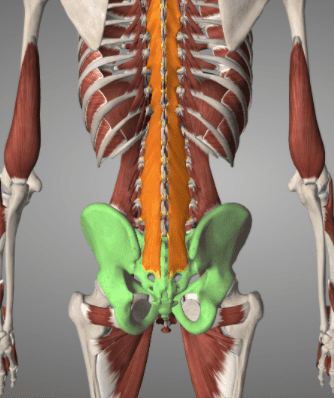
Our body is one big tensioning system: Whatever it is attached to, it pulls on. If there is a force pulling on our pelvis and sacrum, it can pull enough to stretch out our small hip muscles that connect our pelvis and sacrum to our hip. These small hip muscles, highlighted below, are responsible for motions such as rotating your leg and stabilizing your hip in its socket. Again, since we cyclists only move in a forward motion, those muscles that are supposed to stabilize our hip when we move in other directions are not used, and therefore weaken, just like in our back.
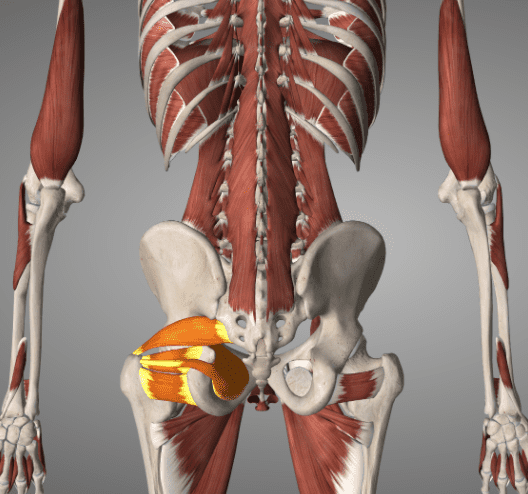
How This All Connects Down To Knee While Cycling
Most cyclists are familiar with a strip of connective tissue called our iliotibial, or IT band (ITB for short). What is lesser known is the muscle that is attached to the IT band called the tensor fasciae latae, or TFL. The TFL is connected to the pelvis. If our muscles in our hip that are highlighted above are weak, the TFL tightens in an attempt to do their work and stabilize the hip. When the TFL tightens, it pulls on the IT band. The ITB is connective tissue. It cannot contract like muscle. So when we feel our ITB is tight, it’s actually because the TFL muscle is in a shortened and contracted position, tensioning the IT band. Our ITB connects all the way from our hip to below our knee, so when the TFL that attaches to it is tight, it will apply unsymmetrical force down at the knee, causing knee pain while cycling.
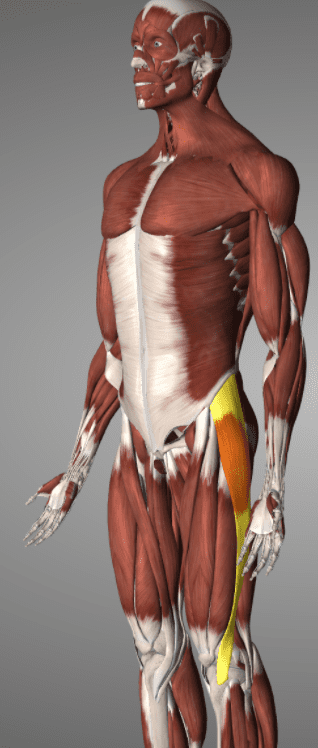
Tensor Fasciae Latae and Iliotibial Band
An adage that we like in PT is “the culprit is silent, the victim cries out”. As you can see from above, oftentimes the place we’re having pain is not the cause of our pain. If you only try to treat the pain at your knee without addressing the root cause, you’ll have a hard time getting rid of that knee pain while cycling and keeping it gone. That’s why it is important to have a physical therapist that evaluates your body as a whole, as everything from our knee all the way up to our back and even our shoulders and neck is connected.
If you’ve tried several things to address your knee pain on the bike and nothing is helping, click the button below to apply for a Discovery Visit with our expert physical therapists to determine the root cause of your knee pain and get you back to riding the bike pain-free.
Many cyclists experience knee pain while cycling. Oftentimes, it’s after you’ve been pedaling for a while and then that nagging feeling starts. Most commonly, it begins at the side of your knee or right over your knee cap. You start to mess with your cleat position, or change your saddle height, but it’s still there. No matter what you change with your fit, or how much foam rolling you do, the pain keeps coming back. Oftentimes, it’s because that knee pain while cycling that you’re experiencing may be coming from your back.
How The Muscles In Our Back Affect Our Hips And Knees
In our back, there are muscles that help stabilize our spine. The ones closest to our spine (and therefore most important in stabilizing it) are the multifidi. They are responsible for rotational movement. As cyclists, we move in just one plane: forward. Therefore, the muscles that perform rotation of our trunk are used less and less and become weak. When a muscle is weak, other muscles have to try to take over for it in order to stabilize our spine appropriately. When muscles have to do tasks that aren’t their job, they tighten and stay tight. (This is why we also see a lot of cyclists with back pain and tightness).

The multifidi muscles, responsible for stabilizing and rotating our spine
Next up, The Hips
You’ll notice that our multifidi connect all the way down to our pelvis and sacrum.

Our body is one big tensioning system: Whatever it is attached to, it pulls on. If there is a force pulling on our pelvis and sacrum, it can pull enough to stretch out our small hip muscles that connect our pelvis and sacrum to our hip. These small hip muscles, highlighted below, are responsible for motions such as rotating your leg and stabilizing your hip in its socket. Again, since we cyclists only move in a forward motion, those muscles that are supposed to stabilize our hip when we move in other directions are not used, and therefore weaken, just like in our back.

How This All Connects Down To Knee While Cycling
Most cyclists are familiar with a strip of connective tissue called our iliotibial, or IT band (ITB for short). What is lesser known is the muscle that is attached to the IT band called the tensor fasciae latae, or TFL. The TFL is connected to the pelvis. If our muscles in our hip that are highlighted above are weak, the TFL tightens in an attempt to do their work and stabilize the hip. When the TFL tightens, it pulls on the IT band. The ITB is connective tissue. It cannot contract like muscle. So when we feel our ITB is tight, it’s actually because the TFL muscle is in a shortened and contracted position, tensioning the IT band. Our ITB connects all the way from our hip to below our knee, so when the TFL that attaches to it is tight, it will apply unsymmetrical force down at the knee, causing knee pain while cycling.

Tensor Fasciae Latae and Iliotibial Band
An adage that we like in PT is “the culprit is silent, the victim cries out”. As you can see from above, oftentimes the place we’re having pain is not the cause of our pain. If you only try to treat the pain at your knee without addressing the root cause, you’ll have a hard time getting rid of that knee pain while cycling and keeping it gone. That’s why it is important to have a physical therapist that evaluates your body as a whole, as everything from our knee all the way up to our back and even our shoulders and neck is connected.
If you’ve tried several things to address your knee pain on the bike and nothing is helping, click the button below to apply for a Discovery Visit with our expert physical therapists to determine the root cause of your knee pain and get you back to riding the bike pain-free.


